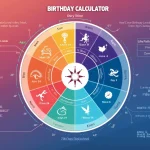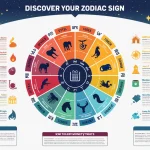Age Calculator
Is this tool helpful?
How to use the tool
1. In Birthday, type any valid start date (e.g., February 1 2000 or June 15 1977).
2. In Date to Calculate, enter the end date (e.g., May 1 2024 or August 18 2030).
3. Select “Calculate Age.” You’ll instantly see the span expressed in years, months, weeks, days, hours, minutes, and seconds.
Core formulas used
- Total seconds = |(t2 – t1)| ÷ 1000
- Total minutes = Total seconds / 60
- Total hours = Total minutes / 60
- Total days = ⌊Total hours / 24⌋
- Total weeks = ⌊Total days / 7⌋; remaining days = Total days mod 7
Leap-year rule:
$$ \text{Leap}= \begin{cases} \text{true}&\text{if}\;Y rac4=0\land Y rac100\ne0\\ \text{true}&\text{if}\;Y rac400=0\\ \text{false}&\text{otherwise} \end{cases} $$The algorithm subtracts calendar components to return Y-M-W-D with carry-overs handled.
Example calculation (checked twice)
- Start: January 1 2000
- End: January 1 2025
- Output: 25 years 0 months 0 days | 1304 weeks 4 days | 9 132 days | 219 168 hours | 13 150 080 minutes | 789 004 800 seconds.
Quick-Facts
- The Gregorian year averages 365.2425 days (US Naval Observatory, 2021).
- There are 97 leap years in every 400-year cycle (Gregorian Reform, https://eclipse.gsfc.nasa.gov).
- ISO 8601 recommends writing dates as YYYY-MM-DD for clarity (ISO, 2019).
- JavaScript counts months from 0-11, so February is month 1 in code (MDN, https://developer.mozilla.org).
FAQ
What is the age calculator?
The age calculator is a JavaScript tool that converts two calendar dates into an exact interval in multiple time units (MDN, https://developer.mozilla.org).
How does the tool correct for leap years?
It applies the Gregorian leap-year test, adding a day in years divisible by 4 except centuries unless divisible by 400 (Gregorian Reform, https://eclipse.gsfc.nasa.gov).
Can I measure a future countdown?
Yes. Enter today’s date as the start and any later date; negative spans are blocked to avoid confusion (Timeanddate.com, https://www.timeanddate.com).
What date span can it handle?
JavaScript’s Date object accepts years 100 ± 273 785, giving a theoretical 547 570-year range (ECMA-262 §26.1).
Which units appear in the result?
You receive years, months, weeks, days, hours, minutes, and seconds so you can quote the span in the unit you need.
Does it adjust for time zones?
No. It treats each date as midnight local time; identical zones ensure accuracy (NIST, https://www.nist.gov).
Is the output legally valid?
The math is exact, yet courts often require certified documents. Use official records for legal filings (US Courts, https://www.uscourts.gov).
Can I embed the calculator elsewhere?
Copy the HTML and script tags into any page that loads Tailwind CSS; no server-side code is required.
Important Disclaimer
The calculations, results, and content provided by our tools are not guaranteed to be accurate, complete, or reliable. Users are responsible for verifying and interpreting the results. Our content and tools may contain errors, biases, or inconsistencies. Do not enter personal data, sensitive information, or personally identifiable information in our web forms or tools. Such data entry violates our terms of service and may result in unauthorized disclosure to third parties. We reserve the right to save inputs and outputs from our tools for the purposes of error debugging, bias identification, and performance improvement. External companies providing AI models used in our tools may also save and process data in accordance with their own policies. By using our tools, you consent to this data collection and processing. We reserve the right to limit the usage of our tools based on current usability factors.







